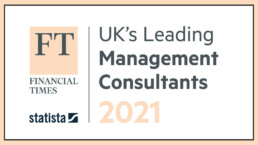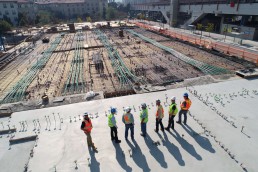UK’s Leading Management Consultants 2022
We are delighted to have been recognised for the fifth consecutive year as one the ‘UK’s Leading Management Consultants 2022’ by the Financial Times.
Recommended across 8 categories and with our first Gold Award, the annual rating, compiled with data company Statista is based on endorsements by clients and peers and demonstrates our consistent year on year sector and service line growth.
Consulting companies are awarded Bronze (recommended), Silver (frequently recommended) or Gold (very frequently recommended).
Sectoral expertise
- Construction & Infrastructure – Gold
- Financial Services – Silver
- Public & Social Sector – Silver
- Healthcare – Bronze
Consulting services
- Digital Transformation – Silver
- Operations & Supply Chain – Silver
- Strategy – Silver
- Sustainability – Bronze
Managing Partner Andrew Morgan said
We are absolutely delighted to see the continued progression of Curzon, competing alongside some major consulting brands. I am so proud of the team, and this emphasises their commitment and dedication to deliver tangible results for our clients in a range of markets through strategic, operational and transformation delivery.

CONTACT US TO FIND OUT HOW WE CAN HELP
Congratulations to Our 2021 MCA Awards finalists
We are delighted to announce that Curzon Consulting are finalists in 2 categories of the Management Consulting Awards 2021, representing the very best of our consulting business.
Established by the Management Consultancies Association, the #MCAAwards demonstrate the transformational work the sector has undertaken during the last challenging twelve months.
2021 marks the seventh consecutive year that Curzon Consulting has been finalists at the prestigious awards.
Commercial Excellence
Curzon with AIG – ‘Back to Life’ – Fast-Tracking to Leadership in Customer & Profit Retention
Read More
After a period of impressive top-line growth, AIG Life’s leadership now concentrated on driving for profitability on a US GAAP basis. Working with Curzon to isolate what could best deliver profit uplift, we zoomed in on a stubbornly un-moving customer persistency rate and recognised that every 1% point of lapse averted would yield significant and multiplicative profit gains.
Curzon was engaged on an ambitious programme to rapidly get control of lapse and release commercial benefit, and to build the capability to achieve best practice retention management. This was an enormous challenge given the starting point: no set persistency strategy, an absence of key lapse analytics, retention not owned or resourced in the organisation, and a lack of lapse prevention and turnaround processes.
Over 11 months through 2019, we took a pragmatic, agile, and ‘together’ approach to accelerate to retention excellence, securing the organisation’s buy-in to what it would take to get there, and quickly demonstrating the commercial, operational and customer benefits of joined-up retention management. Curzon enabled the new cross-functional working essential for success, and gave the business the structures and confidence to operate highly effective preventative and save processes – internally and leveraging external partners.
Among the prime watershed moments were revealing how:
- a shift in distribution mix from advised face-to-face to telesales had created a hitherto unseen problem of drop-out inside first 3 months
- customer communications from welcome onwards needed to explain clearly the personal value of life insurance, and how holding it ensures financial provision for those you love
- rather than automatically cancelling customers on request, customer service had a responsibility to engage them before they make a potentially uninformed decision
When the business took the reins 3 months after improvements were implemented, lapse rate had been reduced to the best practice % mark on a run-rate basis and incremental revenue and profit benefit unlock was exceeding our original target. This translated annualised into 5-figure policy saves and a cumulative £multi-million gain in Pre-Tax Operating Income by 2023. The business had taken ownership of a new retention management function, with a new Lapse MI suite providing the predictive insights to continually optimise retention. Beyond achieving the agreed objectives, the work also led to complementary projects including work to minimise drop-out in the Bank partnership sales channel.
Commenting on the success, AIG Life CFO Donald MacLean said:
“Curzon helped us obtain the confidence and operational ‘can-do’ to get control of lapse sooner than we could have expected, and then to push on to best practice performance.
As always, their skill was in balancing pace of change and the results imperative with the need to take the organisation with them on the journey. A key achievement was building the necessary collaboration between the many functions that needed to act together to manage retention in a joined-up way.
The result was a tangible and ongoing commercial win, and a vital new balance struck between sales and retention for business profitability and sustainability”
People
Curzon with Highways England – ‘Project Performance Accelerator – Enhancing delivery capabilities through innovative approaches and working relationships to achieve HE delivery goals
Read More
Project Performance Accelerator (PPA) was designed to develop and implement a delivery mechanism for Highways England’s (HE) overarching Business Transformation Programme, addressing inconsistent levels of capability throughout HE’s Project Management community and developing highly skilled project delivery teams. Overall, HE’s three main Major Project programmes account for 80 projects worth more than £23bn, each being delivered by a supply chain or contractor led by a Project Management team.
PPA’s leader Steph Illingworth engaged Curzon to interpret and structure her Vision of the PPA Programme into clear deliverables, shaping the fundamentals. There was consensus on cultural flaws and ineffective ways of working. Revealing a deeply siloed organisation with multiple departments or technical areas that lacked collaboration or a holistic view of the primary objectives and deliverables: projects were not executed on time and within budget, nor maximising benefits and social value. Also, capability development and training programmes were too theoretical and onerous, focusing on processes and systems rather than people, impacting the overall project success.
Focusing on performance management, capability development, project control capability and enhancing commercial acumen, the PPA Programme included two outputs as the medium for change: An Immersive Learning Experience and Digital Project Management Guidebook.
The Immersive Learning experience was designed to disrupt the way programmes are delivered. The Digital Project Management Guidebook contained PM content selected through independent reviews and capability assessments. Both outputs were crafted around the project lifecycle of typical HE infrastructure projects, set to be delivered in-person over a period of 18 months. Cohorts were selected to receive a tailored experience, improve project team maturity, and provide a solid foundation for capability uplift to achieve clear learning outcomes and benefits.
At the heart of the PPA philosophy was to enable project teams to grow, enhancing ‘ways of working’ whilst bolstering project performance. These included a “working better together model”; a fundamental shift in the way individuals interact and take ownership of overlapping project aspects and problem-solving techniques. This, along with the Immersive Learning, reinforced the Programme’s success, shifting the focus from systems and processes to people.
The pandemic introduced significant challenges, necessitating the immediate conversion of the Programme from in-person workshops to a virtual setting. The team adapted structures and materials, incorporating a variety of software suites to enhance the learner experience. Frequent interaction and close collaboration with the internal and senior stakeholders were critical to maintaining speed and delivery, adopting a fail-fast, fix fast approach to syllabus creation
The consulting team could interpret the client’s vision into a clear pathway, support and enhance the design to become one of the most successful transformation project delivered in HE.
The Digital Project Management Guidebook launched in August 2020 via four interactive webinars to c.300 employees have now received over 1,000 unique viewers. A modified deployment strategy was adopted in light of the pandemic, redesigned as a remote Immersive Learning Experience. However, over 5,049 hours of remote learning have been received by 100 staff through 9 project teams, enhancing teams’ capability with a combined portfolio value greater than £3.3bn.
Congratulations to all of the other finalists.

CONTACT US TO FIND OUT HOW WE CAN HELP
UK’s Leading Management Consultants 2021
Ranked in the Top 20 of the UK’s consulting firms, we are delighted to have been recognised for the third consecutive year as one of the ‘UK’s Leading Management Consultants 2021’ by the Financial Times.
Recommended in seven categories compiled with data company Statista, the annual rating is based on endorsements by clients and peers and demonstrates our steady consistent year on year sector & service line growth.
Consulting companies are awarded Bronze (recommended), Silver (frequently recommended) or Gold (very frequently recommended).
Sectoral expertise
- Construction & Infrastructure – Silver
- Financial Services – Bronze
- Healthcare – Bronze
- Public & Social Sector – Bronze
Consulting services
- Digital Transformation – Bronze
- Operations & Supply Chain – Bronze
- Strategy – Silver
Managing Partner Andrew Morgan said
We are thrilled to see the continued progression of the firm, competing alongside some major consulting brands. I am really proud of the team and this reinforces their dedication to deliver tangible results for our clients in a range of markets through strategic, operational and transformational delivery.

CONTACT US TO FIND OUT HOW WE CAN HELP
Curzon supports public sector as G-Cloud 12 supplier
Curzon Consulting is delighted to have been awarded a place on G-Cloud 12 framework. We provide five key cloud-related services to the public sector:
Business Transformation
Curzon Consulting delivers transformation and step-change capability improvement. Our services help clients translate strategic imperatives into realised benefits.
Digital Transformation
We help organisations to explore and exploit technology and innovation, including cloud-based services, to improve responsiveness, resilience, effectiveness and efficiency. Our digital transformation services include evaluation of current maturity, opportunity exploration, Design Thinking to reimagine the way work is done, bespoke applications, and implementation planning and delivery of solutions.
Change Management
Curzon Consulting provides change management expertise and support to digital and cloud service migration programmes. Services include business-led interfacing with technical teams, defining governance models, organisational design and migration planning, and working with the organisation to define and deliver the process and behavioural changes required to secure the planned benefits.
Cloud Strategy
Curzon Consulting helps organisations develop winning digital and cloud strategies; robust, achievable, supported and with a clear path to implementation. Our service includes analysis of current state and maturity, opportunity landscape evaluation, articulation of priorities and benefits, and development of a cloud strategy roadmap aligned to the wider organisation direction.
Programme and Project Management Delivery
Curzon provides programme management support across the lifecycle to underpin successful deployment of digital and cloud service innovation. Services include business requirements framing, governance, implementation delivery management and assurance, and corrective action intervention. We apply a business-outcome approach, maintaining focus on achieving and sustaining delivery of the stated benefits.
CONTACT US TO FIND OUT HOW WE CAN HELP
Digital productivity management in infrastructure
The full package: digitising productivity management in infrastructure delivery
Infrastructure owners and construction companies are selecting or developing, and then seeking accelerated implementation and scaling of, their preferred digital productivity management tool(s).
In consideration of the current economic climate, the critical role that Infrastructure investment is set to play in boosting growth has been amplified.
In light of these two factors, it does not feel as though there could be a better time to suggest that if we are going to do the whole ‘digital productivity thing’ in infrastructure and construction… we should do it properly. So, what does ‘doing it properly’ mean? It means that it is time to assess the full spectrum of construction-site productivity management capability areas that can be enhanced through the new or improved application of digital tools. We need the full package.
Unlocking greater efficiencies through digital
Digital enablement has revolutionised productivity and the definition of efficiency norms in other industries. Most notably in Manufacturing industries such as Fast-moving consumer goods (FMCG) where market leaders such as Unilever have reduced material factory waste by more than 40% by digitally enabling end-to-end quality management. (Source: World Economic Forum, How manufacturing can thrive in a digital world and lead a sustainable revolution, January 2020)
Similarly, by 2025 the digital enablement of Logistics has the potential to reduce global carbon emissions by 11%. (Source: World Economic Forum, Digital Transformation of Industries Demystifying Digital and Securing $100 Trillion for Society and Industry by 2025, January 2016) A powerful endorsement of advanced productivity management tools.
The Agriculture industry presents further evidence. Here, as an example, data gathering and historical analysis data-driven decision-making tools are having a transformative impact on crop productivity.
Productivity management in infrastructure however is often driven by manual cost and performance benchmarking processes. Some efficiency gains have been achieved through the successful adoption of Lean methodologies. But the meaningful use of digital tools that enable higher productivity rates will be key to unlocking much greater efficiencies in the construction phases of infrastructure programmes.
There is an entire spectrum of construction site productivity management capability areas that can be enhanced through the application of digital tools. These can be broadly placed into three categories:
- Planning and Collaboration: Ensuring the feasibility of planned activities and improving communications between the site and site-office
- Data gathering: Gathering data on the work accomplished on-site to feed performance/progress metrics
- Data-driven analytics: Collecting historical productivity data on-site to feed data-driven decision making
In pursuit of significant improvement
Organisations tend to focus on the independent application of a discrete digital tool to enable productivity. Most often this means dedicating themselves to a data gathering tool for the purpose of productivity tracking. However, in the pursuit of significant efficiencies it is not sufficient to introduce digitally enabled capability to just one area of the productivity management spectrum. For infrastructure delivery, at the construction site level, a suite of digital tools covering the full range of capabilities (outlined at a high level by the three categories above) is required. Many of the more recently developed tools incorporate data as a service (DaaS) offerings but there is the opportunity to go further. Attributes for productivity information gathered, processed and analysed should adhere to the standards set by data and information frameworks being built by infrastructure owners.
For data generated by any suite of tools, there is the opportunity to actively inform cost and performance benchmarks and subsequently productivity norms for the delivery of work. This applies within the integrated environment for information that programmes, alliances or organisation level data frameworks house.
So how to decide on which digital productivity management tools to work with?
Whether through in-house development or accessing solutions already in play, several factors should be considered, including but certainly not limited to:
- Ease of implementation
- Supply chain buy-in
- Scalability across multiple construction disciplines
Prioritisation frameworks can be designed and applied to rapidly assess an entire landscape of digital productivity management solutions, thoroughly reviewing each through the lenses of standard attributes.
Digital productivity done properly
Individual tools applied in isolation in areas such as productivity tracking can offer benefits. But there is an entire spectrum of on-site productivity management capability that can be enhanced through the application of digital tools. These benefits can be amplified through alignment with the principles for data defined by information frameworks being developed by infrastructure owners. Other industries are demonstrating the scale of productivity benefits available through digital enablement. These are most notable where a complete end-to-end process approach is adopted.
So, if we are going to do the whole ‘digital productivity thing’ in infrastructure and construction… we should do it properly.
The authors
How we can help: Rapid Digital Portfolio Prioritisation
Siloed innovation, functional misalignment and data ‘doing its own thing’ are just a few challenging features of the current congested-frontier of digital transformation.
Applying our bespoke prioritisation framework(s), Curzon Consulting takes 4-6 weeks to rapidly assess an organisation’s entire landscape of digital solutions and initiatives. We thoroughly review each through the lenses of attributes that are orientated around features such as financial benefit, scalability and interoperability.
Get in touch to find out how we can help or arrange a free virtual meeting with award-winning Principal consultant, Edem Eno-Amooquaye.
Want to find out more or meet one of our Infrastructure team? Contact us by email, phone or our web form.
Building organisational capability to drive rapid performance improvement
The issue
- Curzon Consulting were initially engaged to define the programme efficiencies of a public body with a target of £302m for the current investment period
- Alignment of financial targets and scope at scheme level enabled us to provide assurance that the programme will succeed
- It also revealed that there were some critical underlying issues around people and processes that needed practical solutions
- Project configuration and change control were not historically managed well across the programme; project baselines were not agreed/recognised, and redesign often occurred
- There was an embedded Process Compliance culture. People were more concerned on outputs and checklist completion than project outcomes and performance
- There was inconsistency in capabilities and performance among the PM community. Projects seemed to follow contractor’s agenda rather than the client’s
- Project and programme performance was poor and in general all projects were over budget and running behind schedule, costing millions to the Programme
What we did
- Assessment of the management capability to implement change and mobilise the workforce
- Analysis and prioritisation of the project management capability gaps for current and future operating model
- Project lifecycle process mapping to understand gaps, levers and weak points
- Communication of spend profiles to focus on project high cost and critical path activities
- Reinforcement of the role of the PM in the operating model and the support available from specialist functions
- Development of an on-the-job training approach to deliver immediate results and simultaneously start to address the capability challenges for long term results
- Focus on people behaviours around process adherence and promote and install an intense focus on project performance to achieve the Programme’s objectives
- Set performance indicators that were aligned towards outcomes, rather than outputs, to bring performance visibility

The results
- Established a holistic view for an integrated project configuration and control framework. Programme has visibility on project progress and Project Manager development
- Increased alignment to project configuration and adherence to the baseline
- Created and installed a clear set of impactful project cost, schedule and risk related metrics. These are now being used for project performance management
- Improved forecast stability and reduced risk exposure






CONTACT US TO FIND OUT HOW WE CAN HELP
Evaluating structural entity options for a new arm of government transport body
The issue
- Embryonic consulting business established one year ago by a local government body responsible for transport, to monetise and deploy in-house specialist experience
- Consulting business deeply embedded in one of the organisation’s existing holding companies
- Business had not yet established the appropriate frameworks for managing revenue, project delivery, Intellectual Property and assets
- The client wanted to review the optimal entity structure for its Consulting business in order to better drive commerciality
- Strong desire to set up the Consulting business using an entity structure that fostered commerciality and leveraged in-house resources in the most optimal way
- Clear focus on building a profitable revenue funnel, self-financed growth, better IP and asset monetization, capitalisation on tax benefits, simplified and robust governance and transparent risk management
- Aim to start competing for, or partnering with big organisations to, deliver Advisory, IP and Operations & Maintenance contracts
What we did
- Conducted an exhaustive benchmarking exercise to provide the client with insights into how other service utility organisations have established successful Consulting businesses
- Defined a robust set of design principles and considerations for reference throughout the operating model design exercise
- Identified and shortlisted a set of structural options following a complete option evaluation in terms of feasibility and suitability
- Conducted end-to-end scenario testing, using carefully selected in-flight example bids, across the shortlisted structural options
- Refined the final structural model based on outputs of the scenario testing, for proposing to the client’s Finance Committee.

The results
- A benchmarking report, providing a crystallised view of the comparator landscape, including assessment of comparator suitability, and a summary of key insights and recommendations
- A report outlining the full assessment of entity options against a set of robust criteria and the rationale for down-selection
- A recommended structural model, clearly outlining three distinct entity options catering to the distinct requirements of each activity stream
- A high-level timeline illustrating implementation options and a trajectory of maturity
- A concise, crisp report containing key messaging for the Client to socialise to key stakeholders in order to secure Board approval
An award-winning team






CONTACT US TO FIND OUT HOW WE CAN HELP
Driving performance in public sector infrastructure
Nigel Brannan highlights the importance of mastering the basics for a performance focused infrastructure organisation.
The performance challenge
Public sector organisations have long recognised the need to be more outcome and performance focused. While signalling the right intent, many struggle to translate desired outcomes into tangible outputs from their employees and suppliers.
A general ethos of reducing cost above all else compounds this challenge. Furthermore, the organisations often outsource the problem to a supply chain that is increasingly fragmented and under pressure to bid for contracts at very low margins. Suppliers then hope to make money from variations to the original contract that either were not or could not be specified up front, often taking advantage of their client’s poor planning, organisation or decision making.
The supply chain
Partnerships and collaborations are often touted as mechanisms for delivery assurance and improved performance but there are still significant inconsistencies in their effectiveness and practicality. The biggest challenge is usually to align organisations around incentives, which often involves increasing risk in exchange for higher profit, and ensuring that all parties are focused and organised around a common outcome. This is easier said than done.
For major, complex infrastructure projects, it extends beyond the physical construction effort to incorporate the planning and design phases. The public and political outcry at the spiralling cost of many high-profile programmes, or fear that they will overspend significantly, comes from a perceived inability to nail critical decisions, and plan and design in a reasonable timeframe. There are many political reasons why the champions of HS2, Hinckley Point C and Heathrow’s third runway continue to say those projects will deliver for the quoted costs, but the odds are that they will not.
The role of innovation
Innovation and digitisation play important roles in improving the performance of infrastructure organisations. Much of our work involves implementing innovation and digital strategies, but we do it through the lens of following the money. That means mastering the basics of productivity and performance, which starts with knowing what your core success measures are and how you are performing. In infrastructure delivery, you need right to left planning. This means working backwards from the answer on what needs to be in place and by when to hit key milestones and performance outcomes.
The move towards a performance management culture
Curzon & Company is currently partnering with a major public sector infrastructure client to move the organisation towards a performance management culture.
There are three stages in addressing the performance challenge –
Scan, Focus and Act:
- Scan establishes the baseline, trajectory and key drivers of performance. One critical output is a single version of the truth across scope, activity, cost and risk
- Focus is about prioritisation and channelling effort to where it has most impact. Major wins often come from an emphasis on looking forwards and addressing future risks rather than reporting historical performance.
- Act means actually doing things differently. It involves engaging the organisation and their partners at programme and project level to adopt new ways of working. Common measures, good information and ‘heartbeat’ disciplines get results.
None of this is rocket science, but it is remarkable how many organisations struggle to put it into practice.
The benefits
Our client now has transparency of previously hidden efficiencies, providing them and their regulator with the confidence that they are meeting their commitments. They can manage the affordability of the programme proactively – a key benefit where scope requirements evolve over time.
They are offsetting build cost risks by focusing on high-cost elements with standardised product design and productivity benchmarks. Most importantly, they are deploying tools and disciplines at project site level where success (or failure) is delivered.
The successful partnership between the client team and Curzon continues, helping to strengthen the foundations as the client migrates towards a new operating model.

This article originally featured in Raconteur, March 2019
About the author

Nigel Brannan
I lead Infrastructure at Curzon Consulting
I've over 30 years of consulting experience leading major transformation programmes and strategy assignments with major utilities, transport and civil engineering organisations.



















